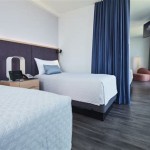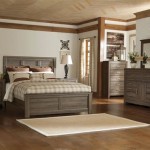The Enduring Appeal of the 1-Bedroom, 1-Bathroom House
The 1-bedroom, 1-bathroom house represents a significant segment of the housing market, catering to a diverse range of individuals and circumstances. Its compact size, relative affordability, and ease of maintenance make it an attractive option for single individuals, young couples, retirees, and those seeking a simplified lifestyle. This article explores the key attributes, advantages, and target demographics of the 1-bedroom, 1-bathroom house, providing a comprehensive overview of its place in the contemporary housing landscape.
This housing configuration, often referred to as a starter home or a condominium unit, offers a practical solution for those with limited living space requirements. The layout typically encompasses a single bedroom, a bathroom (usually equipped with a shower/tub combination, toilet, and sink), a living area, and a kitchen or kitchenette. The overall square footage can vary depending on the location, design, and construction of the property, but generally ranges from 500 to 900 square feet. This size is often considered manageable for one or two occupants, allowing for a comfortable, albeit potentially minimalist, lifestyle.
The affordability of a 1-bedroom, 1-bathroom house is a major draw for many prospective buyers or renters. Compared to larger homes with multiple bedrooms and bathrooms, the purchase price or rental rate is generally lower, making it a more accessible option for those on a tighter budget. This affordability extends beyond the initial cost, as utility bills, property taxes (for homeowners), and maintenance expenses are typically lower than those associated with larger properties. This economic advantage can free up financial resources for other pursuits, such as travel, education, or investments.
Another key advantage of this housing type is its ease of maintenance. With a smaller living space, cleaning and upkeep are significantly less time-consuming and demanding compared to larger homes. This can be particularly appealing to individuals with busy schedules or those who prefer to spend their time on activities other than household chores. The smaller size also reduces the risk of accumulating clutter and encourages a more organized and minimalist lifestyle. Less space often translates to less temptation to fill it with unnecessary possessions.
The location of a 1-bedroom, 1-bathroom house can also be a significant factor in its appeal. These properties are often located in urban areas or close to amenities such as public transportation, shopping centers, and recreational facilities. This proximity to essential services and entertainment options can enhance the quality of life for residents, providing convenient access to work, leisure activities, and social opportunities. Additionally, urban locations often offer a vibrant and diverse cultural scene, attracting individuals who enjoy the energy and dynamism of city life.
The design and layout of a 1-bedroom, 1-bathroom house can vary widely depending on the builder, architect, and intended market. Some units feature open-concept designs, where the living area and kitchen are combined into a single, larger space. This layout can create a sense of spaciousness and facilitate social interaction. Other units may have a more traditional layout, with separate rooms for the living area, kitchen, and bedroom. The choice of layout often depends on personal preferences and lifestyle needs.
The target demographics for 1-bedroom, 1-bathroom houses are diverse, encompassing a wide range of individuals and circumstances. Single individuals, particularly those who are starting their careers or pursuing independent living, often find this housing type to be an ideal fit. Young couples who are just beginning their lives together may also opt for a 1-bedroom, 1-bathroom house as a temporary or long-term living arrangement. Retirees who are looking to downsize and simplify their lives may also find this housing type appealing, as it offers a manageable living space with lower maintenance requirements.
In addition to these primary target demographics, 1-bedroom, 1-bathroom houses can also be attractive to students, traveling professionals, and individuals who spend a significant amount of time away from home. The affordability and convenience of this housing type make it a practical option for those who need a temporary or part-time residence. Furthermore, 1-bedroom, 1-bathroom units are often popular choices for vacation rentals, providing a comfortable and convenient base for exploring a new city or region.
The demand for 1-bedroom, 1-bathroom houses can fluctuate depending on economic conditions, demographic trends, and local housing market dynamics. In periods of economic growth and increased urbanization, the demand for this housing type tends to increase, as more individuals seek affordable and convenient living options in urban areas. Conversely, in periods of economic downturn or increased suburbanization, the demand for 1-bedroom, 1-bathroom houses may decrease. However, this housing type generally maintains a consistent level of demand due to its inherent affordability and appeal to a wide range of individuals.
The long-term value of a 1-bedroom, 1-bathroom house can vary depending on factors such as location, condition, and market trends. Properties located in desirable neighborhoods with strong economies tend to appreciate in value over time, while those located in less desirable areas may experience slower growth or even depreciation. The condition of the property is also a significant factor, as well-maintained units are generally more attractive to buyers or renters and command higher prices. Market trends, such as interest rates and housing supply, can also influence the value of a 1-bedroom, 1-bathroom house.
Affordability and Financial Accessibility
The price point of a 1-bedroom, 1-bathroom residence often makes homeownership or renting accessible to individuals who might otherwise be priced out of larger properties. This affordability directly impacts the ability of younger individuals and those with limited financial resources to enter the housing market. Lower mortgage payments or rent translate to greater financial flexibility, allowing residents to allocate funds to other essential expenses or savings goals.
Furthermore, the reduced energy consumption and utility costs associated with a smaller living space contribute to long-term financial savings. Heating, cooling, and electricity bills are typically lower, reducing the overall cost of living and improving financial stability. This aspect is particularly appealing to budget-conscious individuals and those seeking to minimize their environmental impact.
The lower property taxes, where applicable, also contribute to the overall affordability of 1-bedroom, 1-bathroom homes. This can be a significant factor for homeowners, particularly in areas with high property tax rates. The reduced tax burden can free up additional financial resources for other needs or investments.
Ease of Maintenance and Upkeep
The smaller footprint of a 1-bedroom, 1-bathroom house translates directly into reduced maintenance requirements. Cleaning, repairs, and general upkeep are significantly less time-consuming and physically demanding compared to larger homes. This is particularly beneficial for individuals with busy schedules or those who prefer to delegate household chores.
The reduced square footage also minimizes the potential for accumulation of clutter and encourages a more organized and minimalist lifestyle. Less space necessitates a conscious effort to declutter and prioritize possessions, fostering a more streamlined and efficient living environment. This can contribute to a sense of calm and well-being, reducing stress and improving overall quality of life.
Furthermore, the smaller size of the property reduces the likelihood of major maintenance issues, such as roof repairs or foundation problems. This can save homeowners significant amounts of money and time in the long run. Routine maintenance tasks, such as painting and landscaping, are also less extensive and costly.
Strategic Location and Urban Living
1-bedroom, 1-bathroom houses are often strategically located in urban centers or close to essential amenities and services. This proximity to workplaces, public transportation, shopping centers, and recreational facilities enhances the convenience and accessibility of daily life. Residents can benefit from reduced commute times, easy access to errands, and a wider range of dining and entertainment options.
Urban locations often provide access to a vibrant and diverse cultural scene, with museums, theaters, art galleries, and live music venues. This can be a significant draw for individuals who enjoy the energy and dynamism of city life. Furthermore, urban areas typically offer a greater sense of community and social interaction, with opportunities to connect with neighbors and participate in local events.
The walkability and bike-friendliness of urban areas can also contribute to a healthier and more sustainable lifestyle. Residents can reduce their reliance on cars, promoting physical activity and reducing their carbon footprint. This can have significant environmental and health benefits in the long run.
The 1-bedroom, 1-bathroom house occupies a consistent and relevant position within the housing sector. Its combination of affordability, manageable size, convenient locations, and ease of maintenance continues to attract a wide range of occupants seeking a practical and efficient living solution.

One Bedroom Bath 1 Bed Apartment Ice House Midtown

1 Bedroom Apartment House Plans

1 Bedroom Small House Plan Interior Design Ideas

Plan 85358 With 1 Bed 2 Bath

1 Bedroom Apartment House Plans

House Plan 68572 Traditional Style With 1 Bed Bath

1 Bedroom Floor Plan With Narrow Bathroom And Bathtub

1 Bedroom House Plan Examples

House Plan 201029 Tiny 1 Bedroom Bathroom Floor Instant Download Custom Plans Service Etsy

1 Bedroom Bathroom Apartment Interior Design Ideas








